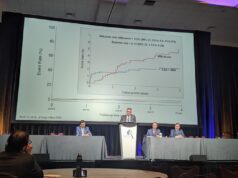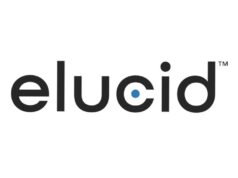 Thirty-day results from the ROADSTER 3 study have demonstrated that transcarotid artery revascularisation (TCAR) is a safe and effective approach in patients who are deemed to be ‘standard risk’ for experiencing adverse events related to carotid endarterectomy (CEA). These findings were presented at the 2024 Vascular InterVentional Advances (VIVA) conference (3–6 November, Las Vegas, USA) by Meghan Dermody (Penn Medicine Lancaster General Health, Lancaster, USA), who—speaking recently to NeuroNews—highlighted the importance of being able to “quote stroke rates that go beyond registry data” for this patient population.
Thirty-day results from the ROADSTER 3 study have demonstrated that transcarotid artery revascularisation (TCAR) is a safe and effective approach in patients who are deemed to be ‘standard risk’ for experiencing adverse events related to carotid endarterectomy (CEA). These findings were presented at the 2024 Vascular InterVentional Advances (VIVA) conference (3–6 November, Las Vegas, USA) by Meghan Dermody (Penn Medicine Lancaster General Health, Lancaster, USA), who—speaking recently to NeuroNews—highlighted the importance of being able to “quote stroke rates that go beyond registry data” for this patient population.
“Since we are unable to conduct an adequately powered randomised controlled trial to study TCAR against other modalities to treat severe carotid stenosis, and especially without a TCAR arm in the forthcoming CREST-2 trial, it is imperative that we study TCAR in a standard-risk population—ideally in a prospective fashion,” Dermody said. “ROADSTER 3 is an FDA [US Food and Drug Administration]-required, post-approval study, but it allowed us the opportunity to acquire data from across the USA with multiple generations of surgeons performing the procedure.”
Touted by Silk Road Medical (Boston Scientific) as the first-ever prospective, multicentre trial evaluating the safety and effectiveness of TCAR using the company’s Enroute transcarotid stent system (TSS) in conjunction with its Enroute transcarotid neuroprotection system (NPS) for the treatment of carotid stenosis in standard surgical risk patients, ROADSTER 3 enrolled a total of 344 patients across 53 US sites for intention-to-treat (ITT) analyses. The single-arm study’s primary endpoint is a composite of major adverse events (stroke, death or myocardial infarction [MI]) through 30 days post-procedure, plus ipsilateral stroke from day 31 to day 365 post-procedure, while incidence of cranial nerve injury (CNI) within 30 days post-procedure is described by the authors as a key secondary endpoint.
In ROADSTER 3’s ITT population, 75.3% of patients were younger than 75 years of age, 42.7% were female, and 16.3% had symptomatic carotid stenosis, with a quarter of these symptomatic patients experiencing a neurologic event within the two weeks preceding their TCAR procedure. Dermody and colleagues report that the mean lesion length was 23.3mm, while 47.4% of patients presented with a Type II or Type III aortic arch, and 17.2% of lesions had severe calcification.
The rate of stroke/death/MI at 30 days in the study’s ITT population was 0.9%—a figure that decreased to 0.6% within per-protocol analyses involving 320 patients. The researchers found that 30-day stroke rates specifically were the sole contributor to these numbers, with no deaths or MIs being reported through the 30-day follow-up. They further relay that the incidence of CNI within 30 days was 0.6% in both the ITT and per-protocol analyses, and that all cases in both of these populations were resolved within six months.
According to Silk Road, this constitutes—to date—the lowest reported rate of adverse event outcomes in a population of standard surgical risk patients treated via carotid revascularisation. The company also claims that, in line with the previous ROADSTER and ROADSTER 2 registry studies, ROADSTER 3 demonstrates consistently low adverse event rates across all risk levels.
“Given TCAR is less invasive than CEA and has similar stroke rates with less nerve injury risk, if a patient is able to take dual antiplatelet and statin therapy, and their anatomy is amenable, there is no reason why TCAR shouldn’t be your first-choice modality,” Dermody told NeuroNews, outlining how the minimally invasive procedure may fit within existing carotid revascularisation paradigms. “But, given the anatomic and physiologic requirements needed for a successful TCAR, naturally, not all patients will be good candidates for this approach.
“Personally, I believe the treatment of carotid stenosis needs to be more focused on the lesion morphology rather than the degree of stenosis alone. The amount of calcification within or around the lesion; the amount of irregularity or ulceration to the atheroma; any thrombus burden within the plaque; arterial wall inflammation; and a slew of other anatomic features, should truly be what we base our shared decision-making on in the future. This requires thorough scrutiny of preoperative imaging, specifically an adequately thin-sliced and well-windowed CT [computed tomography] angiogram.”
Dermody and colleagues also note that symptomatic status did not appear to have a statistically significant bearing on the 30-day incidence of stroke/death/MI, which occurred at a rate of 1% in asymptomatic patients (n=3) versus 0% in symptomatic patients (n=0) in ROADSTER 3’s ITT population, and 0.7% (n=2) versus 0% (n=0) in its per-protocol analysis.
“ROADSTER 3 was not powered to study differences amongst patients based on presenting symptoms, so clinical relevance is difficult to estimate,” Dermody commented. “However, based on multiple previous publications and my own personal experience in practice, the vast majority of patients who present with symptomatic carotid disease are not on best medical therapy at the time of presentation. Adequate management of their risk factors perioperatively is more likely to result in good outcomes, regardless of preoperative symptomatic status.”
Discussing what are likely to be the next key steps in terms of evaluating TCAR, Dermody highlighted the five-year follow-up of these patients—as per a ROADSTER 3 sub-study. In addition, she stated that the future may offer opportunities to study Plavix (clopidogrel) resistance, which is considered a major contributor to post-TCAR stroke, as well as the option to utilise transcarotid flow reversal technology for intracranial neurointerventions.
“There aren’t enough data regarding surveillance of carotid stents, how or when to treat recurrent carotid stenosis within a stent, or long-term outcomes from TCAR yet,” Dermody added. “I look forward to seeing how best medical management compares to CEA and transfemoral carotid stenting in CREST-2.”










